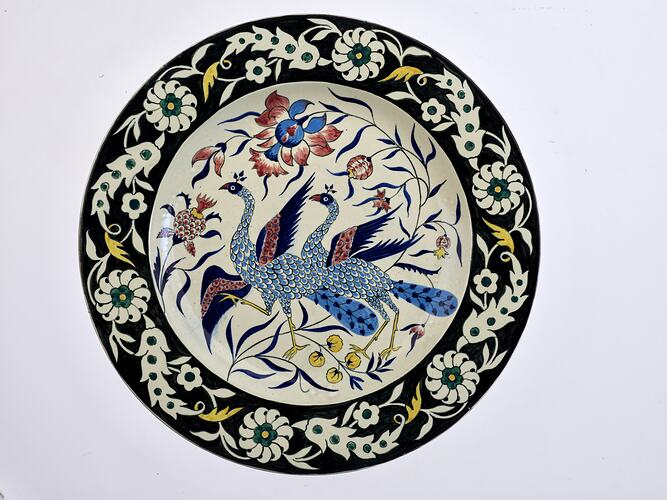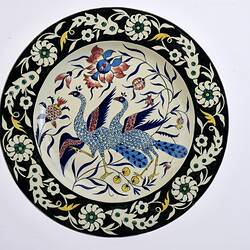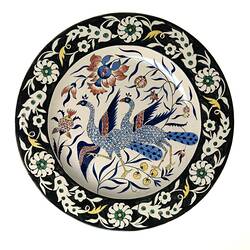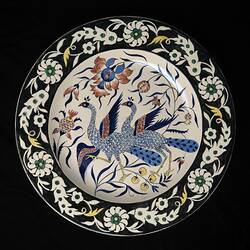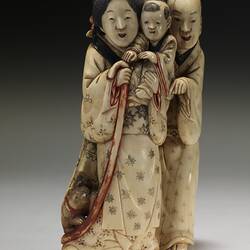Summary
Alternate Name(s): Under Plate.
Italian majolica tin-glazed charger plate featuring an elaborate design of a peacock with flowers, manufactured by C. Tanfani, Rome, circa 1880. C. Tanfani's display of vases in majolica, Etruscan vases, and flower-baskets was awarded a Third Order of Merit (certificate).
A charger is a large underplate used at each place setting on a formal dining table. Salad plates, soup bowls, dinner plates and dessert bowls all sit on top of the charger during each course of the meal. Food is not eaten off a charger plate, it is purely decorative. Chargers were typically made of pewter or metal but can now be made of any material. The use of a charger was most popular during the first half of the 20th century but is used far less often in modern table settings, reserved for special occasions such as weddings.
Majolica, or maiolica ware is a term traditionally applied to a type of tin-glazed earthenware, popular in Italy during the Renaissance. The term is now more broadly applied to any form of tin-glazed ceramic ware influenced by the original Italian majolica and was considered highly collectable in the late nineteenth century.
The technique developed in the Middle East during the 9th century, befored spreading arcoss the Mediterranean, from Spain into Italy, via the island Majorca, from where the Italian term for this style of ceramic derives.
The earthenware object is first fired at a relatively low temperature before being dipped into a fast-drying glaze, which provides the warm, white background colour onto which the later designs are painted. Once this initial base glaze is dried, the design is painted in tin-based glazes and subsequently fired a second time at a higher temperature, producing the deep, rich colours so typical of this style of ceramic.
Physical Description
Tin-glazed earthenware charger, the centre painted with two blue peacocks and flowers. The rim painted with flowers and leaves in white, yellow and green, on black border. Iznic style.
More Information
-
Collection Names
-
Collecting Areas
-
Acquisition Information
Cultural Gifts Donation from Dr Will Twycross, 23 Jan 2009
-
Acknowledgement
Donated through the Australian Government's Cultural Gifts Program
-
Manufacturer
-
Place & Date Exhibited
Royal Exhibition Building (REB), Melbourne, Greater Melbourne, Victoria, Australia, 1880-1881
-
Collector
Mr John Twycross, Elsternwick, Greater Melbourne, Victoria, Australia, 1880
-
Inscriptions
Hand painted signature on underside: Tanfani/ Roma
-
Classification
Royal exhibition building, International exhibitions, Exhibition heritage
-
Category
-
Discipline
-
Type of item
-
Overall Dimensions
410 mm (Width), 50 mm (Height)
-
Maximum dimensions
48 mm (Height), 397 mm (Circumference)
Measurement From Conservation.
-
Keywords
Decorative Arts, Earthenware, Exhibitions: Melbourne International, 1880-1881, Italian Art, Royal Exhibition Building
